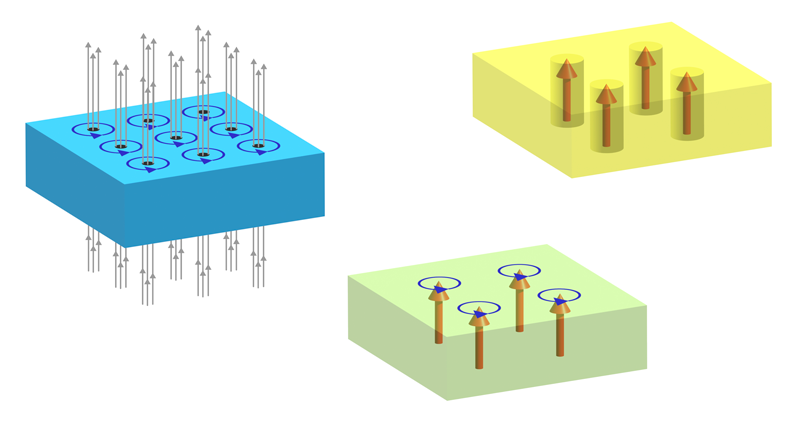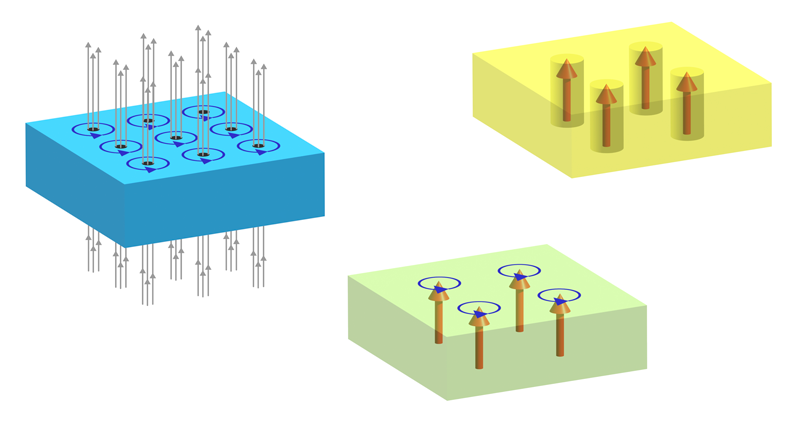Superconducting Vortices Made Without Magnetic Fields
Building a quantum computer is challenging, not least due to computational errors that arise from the interaction of the quantum system with its environment. In principle, this error problem can be mitigated in a fault-tolerant approach called topological quantum computing, which relies on non-Abelian anyons—exotic quasiparticles that can exist only in two dimensions. However, realizing a material system that can host such quasiparticles typically requires a strong magnetic field, which makes device integration tricky. Now Yishi Lin of Fudan University in China and colleagues have detected and manipulated structures called quantum anomalous vortices (QAVs) in the iron-based superconductor Fe(Se,Te) [1]. Remarkably, these structures form in the absence of a magnetic field and could theoretically support non-Abelian anyons known as Majorana zero modes [2].
To understand QAVs, it is helpful to consider the conventional behavior of a superconductor in a magnetic field. Famously, the field will be expelled from the material’s interior through a phenomenon called the Meissner effect if the field strength is below a critical value. A type-II superconductor retains superconductivity to higher field strengths than this value by channeling the field through nonsuperconducting regions known as vortex cores. These regions are surrounded by circulating superconducting currents that shield the field at the cores, forming so-called Abrikosov vortices (Fig. 1, top left).
Rather than applying a magnetic field to a superconductor, isolated magnetic impurities can be inserted into the superconductor. Such impurities break the material’s time-reversal symmetry and locally suppress the strength of the electron-pairing interaction responsible for superconductivity, defined by the magnitude of a key quantity known as the order parameter. The result is a collection of localized states called Yu-Shiba-Rusinov states (Fig. 1, top right). The energies of these states lie in the superconducting gap—a range of energies that are forbidden to single electrons in a superconductor. This picture is modified in the presence of spin-orbit coupling, which couples the magnetic moment of each impurity to the angular momentum of superconducting quasiparticles. In that case, there is a quantized twist of the order parameter around each impurity. This twist forms QAVs (Fig. 1, bottom).
The spontaneous creation of QAVs in the absence of an external magnetic field has an interesting analogy. In 1980, physicists observed the quantum Hall effect—the quantization of the transverse electrical conductance of a two-dimensional electron gas in a strong magnetic field [3]. A longstanding question had been whether a similar phenomenon could exist in the absence of a field. In 2013, scientists detected such a phenomenon, dubbed the quantum anomalous Hall effect [4].
Lin and colleagues have now directly observed QAVs in Fe(Se,Te), a superconductor that has strong spin-orbit coupling and spin-polarized states associated with particular Fe atoms that act as isolated magnetic impurities. The team cooled crystalline flakes of Fe(Se,Te) through their superconducting transition, which occurs at about 14 K. The researchers then used a highly sensitive instrument called a scanning superconducting quantum interference device (sSQUID) microscope to sense and image the magnetic flux emerging from the flakes.
The team detected random patterns of vortices paired with antivortices—structures that differ from vortices only in the orientation of their circulating currents. These patterns were spotted at an applied magnetic field weaker than that corresponding to a single flux quantum and even in the absence of such a field. In this magnetic-field regime, vortices are not expected.
In Lin and colleagues’ experiments, a field coil of the sSQUID microscope generated a weak magnetic field. This field produced a synchronous hysteretic switching of the vorticity—the curl of the flow velocity—associated with each vortex and antivortex. Such behavior is similar to the magnetization switching of a ferromagnet. Furthermore, the superconducting current induced by this weak field drove a rotation of the flux lines threading pairs of impurity magnetic moments. This effect is analogous to the current-induced torque observed in ferromagnets that have spin-orbit coupling [5], and it provides a way to manipulate these vortices.
Surface states in Fe(Se,Te) have been shown to have a nontrivial topological band structure with accompanying superconductivity [6]. Under these circumstances, Majorana zero modes can theoretically form inside the vortex cores of QAVs [7]. Furthermore, the members of a QAV-antivortex pair have opposite vorticities such that they do not repel each other, unlike the Abrikosov vortices seen in conventional superconductors. Consequently, it might be possible to use QAVs to exchange Majorana zero modes in a process known as braiding, a key requirement for topological quantum computing. A potential next step, therefore, is to obtain evidence for Majorana zero modes in these systems and then to explore the conditions needed to manipulate QAVs, albeit slowly to preserve adiabaticity—another important requirement for this type of computing.
References
- Y. S. Lin et al., “Direct observation of quantum anomalous vortex in Fe(Se,Te),” Phys. Rev. X 13, 011046 (2023).
- C. Nayak et al., “Non-Abelian anyons and topological quantum computation,” Rev. Mod. Phys. 80, 1083 (2008).
- K. v. Klitzing et al., “New method for high-accuracy determination of the fine-structure constant based on quantized Hall resistance,” Phys. Rev. Lett. 45, 494 (1980).
- C.-Z. Chang et al., “Experimental observation of the quantum anomalous Hall effect in a magnetic topological insulator,” Science 340, 167 (2013).
- I. M. Miron et al., “Perpendicular switching of a single ferromagnetic layer induced by in-plane current injection,” Nature 476, 189 (2011).
- P. Zhang et al., “Observation of topological superconductivity on the surface of an iron-based superconductor,” Science 360, 182 (2018).
- K. Jiang et al., “Quantum anomalous vortex and Majorana zero mode in iron-based superconductor Fe(Te,Se),” Phys. Rev. X 9, 011033 (2019).





